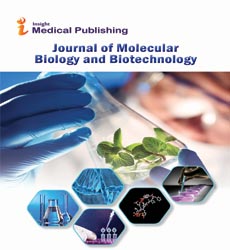A Brief Note on Toxicogenomics
Alex Graudenzi*
Department of Microbiology and Virology, University of Comoros, Mvouni, Comoros
- *Corresponding Author:
- Graudenzi Alex
Department of Microbiology and Virology,
University of Comoros,
Mvouni,
Comoros,
E mail: graudenzi@uw.edu
Received Date: November 17, 2021; Accepted Date: December 01, 2021; Published Date: December 08, 2021
Citation: Graudenzi A (2021) A Brief Note on Toxicogenomics. J Mol Biol Biotech Vol.6 No.S1:001.
About the Study
Toxicogenomics is a sub disciplines of pharmacology that arrangement with the assortment, translation, and capacity of data about quality and protein movement inside a specific cell or tissue of a creature in light of openness to harmful substances. Toxicogenomics combines toxicology with genomics or other high-throughput sub-atomic profiling innovations, for example, transcriptomics, proteomics and metabolomics. Toxicogenomics tries to explain the sub-atomic instruments advanced in the declaration of harmfulness, and to infer sub-atomic articulation designs (i.e., sub-atomic biomarkers) that foresee poisonousness or the hereditary vulnerability to it.
Toxicogenomics may likewise be useful as a safeguard measure to anticipate unfavorable "side", for example harmful, impacts, of drug drugs on defenseless people. This includes utilizing genomic methods, for example, quality articulation level profiling and single-nucleotide polymorphism examination of the hereditary variety of people.
Investigations of those sorts are then connected to unfavorable toxicological impacts in clinical preliminaries with the goal that appropriate analytic markers (quantifiable finishes paperwork) for these antagonistic impacts can be created.
Utilizing such strategies, it would then be hypothetically conceivable to test a singular patient for their weakness to these unfavorable impacts prior to managing a medication. Patients that would show the marker for an antagonistic impact would be changed to an alternate medication. While this methodology is at present hypothetical, it has incredible potential.
Pharmaceutical Research
In drug research, toxicogenomics is characterized as the investigation of the construction and capacity of the genome as it reacts to unfavorable xenobiotic openness. It is the toxicological subdiscipline of pharmacogenomics, which is comprehensively characterized as the investigation of between individual varieties in entire genome or competitor quality single-nucleotide polymorphism maps, haplotype markers, and adjustments in quality articulation that may associate with drug responses. Though the term toxicogenomics first showed up in the writing in 1999, it was at that point currently in like manner use inside the drug business as its starting point was driven by showcasing systems from seller organizations. The term is at this point not by and large recognized, and others have offered elective terms, for example, chemogenomics to portray basically a similar field of study.
Bioinformatics
The nature and intricacy of the information (in volume and fluctuation) requests profoundly created cycles of robotized taking care of and capacity. The examination typically includes a wide exhibit of bioinformatics and statistics, frequently including factual characterization draws near.
Drug Discovery
In drug disclosure and improvement, toxicogenomics is utilized to concentrate on conceivable unfavorable (for example harmful) impacts of drug drugs in characterized model frameworks to make inferences on the poisonous danger to patients or the climate. Both the United States Environmental Protection Agency (EPA) and the Food and Drug Administration (FDA) as of now block putting together administrative decisionproduction with respect to genomics information alone. Notwithstanding, they do energize the deliberate accommodation of all around reported, quality genomics information. The two organizations are thinking about the utilization of submitted information dependent upon the situation for evaluation purposes (e.g., to assist with clarifying component of activity or add to a weight-of proof methodology) or for populating significant relative data sets by empowering equal entries of genomics information and customary toxicological experimental outcomes.
Public Projects
Synthetic Effects in Biological Systems is a task facilitated by the National Institute of Environmental Health Sciences fabricating an information base of toxicology studies including concentrate on plan, clinical pathology, and histopathology and toxicogenomics data.
InnoMed PredTox surveys the benefit of joining results from different omics advances along with the outcomes from more ordinary toxicology techniques in more educated decisionproduction in preclinical wellbeing evaluation.
Open TG-GATEs (Toxicogenomics Project-Genomics Assisted Toxicity Evaluation System) is a Japanese public-private exertion which has distributed quality articulation and pathology data for in excess of 170 mixtures (for the most part drugs).
The Predictive Safety Testing Consortium plans to recognize and clinically qualify wellbeing biomarkers for administrative use as a component of the FDA's "Basic Path Initiative".
ToxCast is a program for Predicting Hazard and Prioritizing the Toxicity Testing of Environmental Chemicals at the United States Environmental Protection Agency.
Tox21 is a government coordinated effort including the National Institutes of Health (NIH), Environmental Protection Agency (EPA), and Food and Drug Administration (FDA), is pointed toward growing better harmfulness appraisal methods. Within this task the poisonous impacts of synthetic mixtures on cell lines got from the 1000 Genomes Project people were evaluated and relationship with hereditary markers were determined. Parts of this information were utilized in the NIEHSNCATS- UNC DREAM Toxicogenetics Challenge to decide techniques for cytotoxicity forecasts for people.
Open Access Journals
- Aquaculture & Veterinary Science
- Chemistry & Chemical Sciences
- Clinical Sciences
- Engineering
- General Science
- Genetics & Molecular Biology
- Health Care & Nursing
- Immunology & Microbiology
- Materials Science
- Mathematics & Physics
- Medical Sciences
- Neurology & Psychiatry
- Oncology & Cancer Science
- Pharmaceutical Sciences
